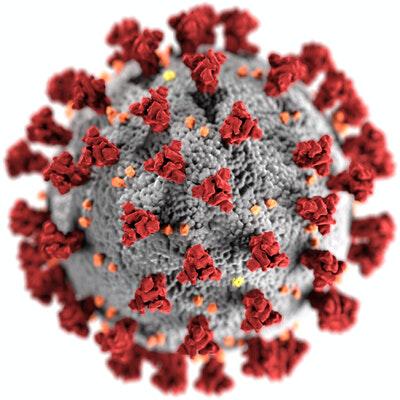Since it was first discovered in Wuhan, China, in December 2019, Coronavirus (COVID-19) has spread across the world, with a global death toll surpassing 1.5m.
Now, as we are in the traditional season for common colds and flu, there is the added complication of COVID-19. The symptoms of the common cold, flu, and COVID-19 can be broadly similar, so it is essential to understand the differences.
What Are Coronaviruses?
 The word "Coronavirus" is an umbrella term for a group of viruses, including the common cold, SARS, and MERS. The term Coronavirus is a morphological description of the virus under an electron microscope. Corona is Latin for "crown" or "wreath," which describes the structure of the virion under an electron microscope—a circle with proteins jutting out from it, resembling a pointed crown.
The word "Coronavirus" is an umbrella term for a group of viruses, including the common cold, SARS, and MERS. The term Coronavirus is a morphological description of the virus under an electron microscope. Corona is Latin for "crown" or "wreath," which describes the structure of the virion under an electron microscope—a circle with proteins jutting out from it, resembling a pointed crown.
Coronaviruses are common among mammals, such as pigs, camels, bats, and humans. Often, viruses remain within the reservoir of a particular species and tend to circulate primarily through specific animals or even breeds, as seen in the case of myxomatosis in European rabbits. Sometimes, viruses can adapt and jump between species, as was the case with swine flu. When a virus jumps from one species to another, it is known as a spillover event.
7 known types of coronaviruses have been found in people, including those responsible for the SARS, MERS, the common cold and the current COVID-19 epidemics.
What Are The Similarities?
COVID-19, the common cold, and the flu are all illnesses caused by viruses that infect the respiratory tract. All are contagious and can spread easily from person to person through close contact.
These viruses can live on surfaces for various time frames, allowing people to pick up the virus and become infected, or infect others. They are more prevalent during the winter months due to the cooler, moist air and the fact that people spend more time indoors together.
The symptoms of these viruses can be very similar, making them difficult to distinguish from one another. Here, we’ll break down the symptoms of these common coronaviruses so that you can tell them apart.
COVID-19 (Novel coronavirus)
COVID-19 is caused by a coronavirus called SARS-CoV-2.
Similar to the flu, COVID-19 mainly spreads through respiratory droplets. When you breathe, sneeze or cough, small droplets of water vapour escape your body. These minuscule droplets can harbour pathogens.
When someone inhales these contaminated droplets, the virus enters the body and begins to establish a presence within it.
As the virus replicates, the immune system tries to rid it from the body. This action of the immune system fighting off the virus is what causes symptoms to occur.
The symptoms can range from mild to severe, and may appear 2-14 days after exposure to the virus. The typical symptoms of COVID-19 are:
- A loss of taste and/or smell
- A new, persistent, dry cough
- Aches and pains
- Fatigue
- Fever
- Headaches
- Shortness of breath
- Sore throat
The virus damages alveoli (air sacs) in the lungs. Your alveoli are responsible for diffusing oxygen into the blood. When the virus attacks cells, the air sacs become inflamed and fill with fluid, reducing their effectiveness. This causes a drop in blood oxygen levels— a condition known as hypoxia.
In some cases, blood clots form in the blood vessels surrounding the alveoli, causing chest pain.
New information is emerging about the long-term effects of COVID-19. Much like the flu, symptoms of the novel coronavirus can linger after the body has recovered. This has been dubbed "long COVID", and scientists are still trying to understand it.
If you suspect you have symptoms of COVID-19, it’s important to get tested. You can find information about how to book a test on the government website or by dialling 119.
Alternatively, you can buy a private COVID-19 test kit online from reputable online suppliers, such as Prescription Doctor.
Since December 2020, several vaccines have been approved against COVID-19, including those from Pfizer/BioNTech, Oxford/AstraZeneca, and Moderna.
How does the COVID-19 vaccine work?

The vaccine uses a specific segment of the virus' genetic code. The segment instructs cells to produce spike proteins—the protrusions on the outside of the virion—but does not contain any instructions to create the virus itself.
These spike proteins are like keys, allowing the virions to bind to and penetrate the membrane of specific cells. Without these spike proteins, the virus cannot infect a host cell and instruct it to create copies of itself.
These spike proteins also act as a unique identifier of the virus. They trigger antibodies to bind to the proteins, preventing them from penetrating cells. Once identified by the immune system, white blood cells are sent to destroy the virus.
By causing the body to produce these specific spike proteins, the body can learn to identify the protein and produce antibodies against it. This prepares the body for when the virus is present.
Common Cold
The common cold is the most prevalent coronavirus, and can infect you at any time of the year, though you are more likely to catch it during the winter months.
The common cold is not caused by spending time in the cold or wearing damp clothes, although these conditions can lead to hypothermia.
Colds are spread easily when people gather in groups, such as during the various winter festivities or when starting university, resulting in the term "fresher's flu". The virus is usually spread by breathing in contaminated aerosols - tiny water droplets in the air which carry the virus.
While there is no cure or vaccine for the common cold, there are treatments that can help manage its symptoms.
Compared to COVID-19 and the flu, the symptoms of the common cold are usually mild and peak within 2-3 days. The typical symptoms of a cold are:
- A mild cough
- A runny or stuffy nose
- A sore/tickly throat
- Aches and pains
- Fatigue
- Fever
- Headaches
- Sneezing
Symptoms of a cold usually last for a couple of days. It's essential to drink plenty of fluids while fighting a cold to stay hydrated.
The common cold can affect people in vastly different ways, as everyone's immune system is unique. For some people, their symptoms are mild enough not to require treatment.
Other people, especially those with underlying respiratory conditions, may experience breathing difficulties or struggle to sleep with a cold.
In addition to the severity, some people may experience gastrointestinal symptoms, such as diarrhoea, when they are infected with a cold.
It is rare for a person to become hospitalised due to a cold, but it can happen. If you are concerned about a cold, whether your symptoms are more severe or have been present for a long time, speak with your doctor.
It is possible to confuse a cold with the flu or COVID-19, as the symptoms of both viruses are very similar. If you are unsure whether you are experiencing a cold or COVID-19, you can use the NHS 111 online system checker.
Flu
Influenza, commonly referred to as the flu, is an acute illness that typically causes more severe symptoms than a cold. It is more prolific during the winter months, which is why a vaccine is often promoted at the start of winter to vulnerable individuals.
Despite causing similar symptoms to the common cold or COVID-19, influenza is not a coronavirus (CoV), but instead a human parainfluenza virus (HPIV).
The symptoms of the flu usually come on suddenly and can drastically affect your life. If you catch the flu, you should mitigate the risk of passing it on to others by staying home and getting rest.
The typical symptoms of flu are:
- A dry cough
- A severe shortness of breath can also develop in some cases
- Aches and pains
- Diarrhoea can sometimes occur in children
- Fatigue
- Fever
- Headaches
- Loss of appetite
- Runny or stuffy nose
- Sore throat
Flu symptoms usually last up to a week, although some symptoms, such as muscle aches, weakness, and cough, may persist for a short time after.
You can usually treat flu symptoms with over-the-counter medications, although some prescription treatments are available, such as Tamiflu.
For the ageing population, the flu is a serious threat and can result in hospitalisation, particularly for those with underlying health conditions or weakened immune systems.
If you have been offered a free flu jab, don't pass up the opportunity to protect yourself. Speak to your GP or your local pharmacy for more information on where to get your free flu jab this winter.
How Can You Prevent Getting Poorly This Winter?
 Winter 2020 will be unlike any other, though the year has taught us some important lessons in disease control. Most of the guidance we've followed throughout the year can arm us against the threat of other common illnesses.
Winter 2020 will be unlike any other, though the year has taught us some important lessons in disease control. Most of the guidance we've followed throughout the year can arm us against the threat of other common illnesses.
Despite the increased risks of COVID-19, there are a number of ways you can protect yourself and others from coughs, colds and flu.
First and foremost, the key to good health is a healthy lifestyle. Eat healthy, nutritious food and stay hydrated. By eating a variety of fresh fruits and vegetables, you can help support your immune system and enhance its effectiveness in fighting off infections.
While it's certainly the time for merriment, avoid excessive alcohol consumption and moderate the amount of processed sugars you consume.
Practice good hygiene to avoid catching germs by washing your hands for at least 20 seconds and scrubbing under your fingernails. Cover your mouth and nose with a tissue—or your sleeve—when you cough and sneeze. Disinfect shared surfaces, such as keyboards, telephones, door handles and remote controls whenever possible. You don't need to go overboard, but being aware of places where germs can survive and keeping them clean can help reduce your risk.
Social distancing, wearing a facemask when outside and adhering to government guidelines are all important to lessen the risk of passing on or catching Covid-19. You can find what restrictions apply in your area on the government website.
Get the flu vaccine if you are eligible. The vaccination is offered annually on the NHS to help protect people at risk of flu and its complications. It is particularly important this year because if you are at higher risk from coronavirus, you are also more at risk of problems from the flu. Additionally, if you contract both the flu and coronavirus simultaneously, you are more likely to experience severe illness.
Taking these preventive measures can help you stay healthy and reduce your risk of getting ill over winter.
What To Do If You Feel Unwell?
If you feel unwell, it is important to pay attention to any worsening symptoms, especially if you fall into a Covid-19 high-risk group, which includes people over 60, people with underlying medical conditions and pregnant women.
If you are experiencing any of the main symptoms of COVID-19, you must get tested as soon as possible. If you test positive for COVID-19, you should self-isolate to prevent passing the virus on to others.
You can also get tested for both COVID-19 and the flu if you have conflicting symptoms, so you can determine which is affecting you.
We offer a range of cold and flu remedies at Prescription Doctor, including Lemsip, Night Nurse, and Beechams. These medicines contain paracetamol - a common painkiller and antipyretic, meaning it reduces feverishness.
These treatments can help reduce the severity of your symptoms while your body fights the infection.
You can also check out our list of natural remedies for a common cold.
If you are unsure about any of your symptoms or which treatments are most suitable for you, speak to your GP or a pharmacist.






